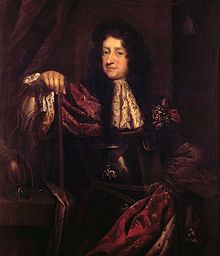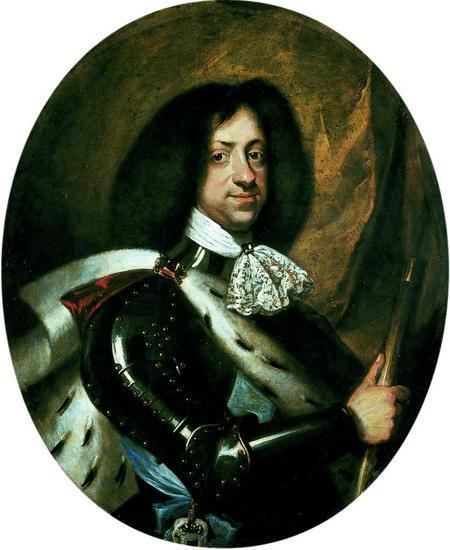Reign 1670–1699 Name Christian of | ||
 | ||
Coronation 7 June 1671Frederiksborg Palace Chapel Issueamong others... Frederick IV of DenmarkPrince ChristianPrincess Sophia HedwigPrince CharlesPrince William Died August 25, 1699, Copenhagen, Denmark Children Frederick IV of Denmark, Christian Gyldenlove Parents Frederick III of Denmark, Sophie Amalie of Brunswick-Luneburg Similar People Frederick III of Denmark, Frederick IV of Denmark, Christian VI of Denmark, Frederick V of Denmark, Christian IV of Denmark | ||
Siblings Prince George of Denmark | ||
Christian V (15 April 1646 – 25 August 1699) was king of Denmark and Norway from 1670 until his death in 1699.
Contents

Well-regarded by the common people, he was the first king anointed at Frederiksborg Castle chapel as absolute monarch since the decree that institutionalized the supremacy of the Danish king, he fortified the absolutist system against the aristocracy by accelerating his father’s practice of allowing Holstein nobles and Danish commoners into state service.

As king he wanted to show his power as absolute monarch through architecture, and dreamed of a Danish Versailles. He was the first to use the 1671 Throne Chair of Denmark, partly made for this purpose. His motto was: Pietate et Justitia (With piety and justice).
Early years
Christian was elected successor to his father in June 1650. This was not a free choice, but de facto automatic hereditary succession. Escorted by his chamberlain Christoffer Parsberg, Christian went on a long trip abroad, to Holland, England, France, and home through Germany. On this trip, he saw absolutism in its most splendid achievement at the young Louis XIV's court, and heard about the theory of the divine right of kings. He returned to Denmark in August 1663. From 1664 he was allowed to attend proceedings of the State College. Hereditary succession was made official by Royal Law in 1665. ChristIan was hailed as heir in Copenhagen in August 1665, in Odense and Viborg in September, and in Christiania, Norway in July 1666. Only a short time before he became king, he was taken into the Council of the Realm and the Supreme Court. He became king upon his father's death on 9 February 1670, and was formally crowned in 1671. He was the first hereditary king of Denmark, and in honor of this, Denmark acquired costly new crown jewels and a magnificent new ceremonial sword.
Reign
It is generally argued that Christian V's personal courage and affability made him popular among the common people, but his image was marred by his unsuccessful attempt to regain Scania for Denmark in the Scanian War. The war exhausted Denmark's economic resources without securing any gains. Part of Christian's appeal to the common people may be explained by the fact that he allowed Danish commoners into state service, but his attempts to curtail the influence of the nobility also meant continuing his father's drive toward absolutism. To accommodate non-aristocrats into state service, he created the new noble ranks of count and baron. One of the commoners elevated in this way by the king was Peder Schumacher, named Count Griffenfeld by Christian V in 1670 and high councillor of Denmark in 1674. Griffenfeld, a skilled statesman, better understood the precarious situation Denmark placed itself by attacking Sweden at a time when the country was allied with France, the major European power of the era. As Griffenfeld predicted, Sweden's stronger ally France was the party that dictated the peace with Denmark's ally Holland, and in spite of Danish victory at sea in the battles against Sweden in 1675–1679 during the Scanian War, Danish hopes for border changes on the Scandinavian Peninsula between the two countries were dashed. The results of the war efforts proved politically and financially unremunerative for Denmark. The damage to the Danish economy was extensive. At this point, Christian V no longer had his most experienced foreign relations counsel around to repair the political damage — in 1676 he had been persuaded to sacrifice Griffenfeld as a traitor, and to the clamour of his adversaries, Griffenfeld was imprisoned for the remainder of his life.
After the Scanian War, his sister, Princess Ulrike Eleonora of Denmark, married the Swedish king Charles XI, whose mother was a stout supporter of the Duke of Holstein-Gottorp. In spite of the family ties, war between the brothers-in-law was close again in 1689, when Charles XI nearly provoked confrontation with Denmark by his support of the exiled Christian Albert, Duke of Holstein-Gottorp in his claims to Holstein-Gottorp in Schleswig-Holstein.
Like Charles XI of Sweden, who had never been outside Sweden, Christian V spoke only German and Danish and was therefore often considered poorly educated due to his inability to communicate with visiting foreign diplomats. Christian V was also often considered dependent on his councillors by contemporary sources. The Danish monarch did nothing to dispel this notion. In his memoirs, he listed "hunting, love-making, war and maritime affairs" as his main interests in life.
Christian V introduced Danske Lov (the Danish Code) in 1683, the first law code for all of Denmark. It was succeeded by the similar Norske Lov (Norwegian Code) of 1687. He also introduced the land register of 1688, which attempted to work out the land value of the united monarchy in order to create a more just taxation. During his reign, science witnessed a golden age due to the work of the astronomer Ole Rømer in spite of the king’s personal lack of scientific knowledge and interest.
He died from the after-effects of a hunting accident and was interred in Roskilde Cathedral.
Family
Christian V had eight children by his wife and six by his Maîtresse-en-titre, Sophie Amalie Moth (1654–1719), whom he took up with when she was sixteen. Sophie was the daughter of his former tutor Poul Moth. Christian publicly introduced Sophie into court in 1672, a move which insulted his wife, and made her countess of Samsø on 31 December 1677.
Legitimate children by his queen Charlotte Amalie:
Illegitimate children by his mistress, Sophie Amalie Moth, Countess of Samsø:
Titles, styles and arms
1670–1699 His Majesty the King: By the Grace of God, King of Denmark and Norway, the Wends and the Goths, Duke of Schleswig, Holstein, Stormarn and Dithmarschen, Count of Oldenburg and Delmenhorst.
